(Optimoitu pieni näyttö laitteisiin)
Downtown, cathedral - Pécs, Unkari
Kun klikkaat:
Klikkaa kuvia!
-

White limestone southern facade of the neo-romanesque Basilica of Pécs, and its 60-meter-high steeples (towers), made of yellowish sandstone from Budafa
Kuvauspäivämäärän: 20092009
Luonut: Robert Németh
Kameran malli: Konica Minolta Dimage A200
Pécs, Unkari
-

Episcopal Palace (the Bishop's Palace)
Kuvauspäivämäärän: 20092009
Luonut: Robert Németh
Kameran malli: Konica Minolta Dimage A200
Pécs, Unkari
-

The columns of the late-11th-centiry-built five-aisled lower church or crypt
The tomb of Janus Pannonius Hungarian poet and bishop can be found on the left edge of the picture.
Kuvauspäivämäärän: 20092009
Luonut: Robert Németh
Kameran malli: Konica Minolta Dimage A200
Pécs, Unkari
-
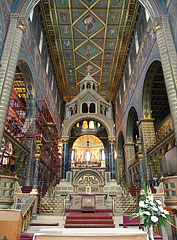
Cathedral of Pécs, sanctuary with the columned ciborium altar, in natural light
Kuvauspäivämäärän: 20092009
Luonut: Robert Németh
Kameran malli: Konica Minolta Dimage A200
Pécs, Unkari
-
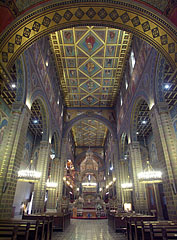
Interior of the Cathedral of Pécs; the nave and the sanctuary, viewed from the western entrance, from under the choir loft and the church organ
Kuvauspäivämäärän: 20092009
Luonut: Robert Németh
Kameran malli: Konica Minolta Dimage A200
Pécs, Unkari
-

Carvings on the wooden door of the Episcopal Palace
Kuvauspäivämäärän: 20092009
Luonut: Robert Németh
Kameran malli: Konica Minolta Dimage A200
Pécs, Unkari
-
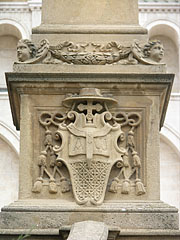
Decoration on the feet of an obelisk, that stands in the square
Kuvauspäivämäärän: 20092009
Luonut: Robert Németh
Kameran malli: Konica Minolta Dimage A200
Pécs, Unkari
-

Biblical scenes cast in bronze, on the double door of the Cathedral of Pécs
Created by Sándor Rétfalvi in 2000
Kuvauspäivämäärän: 20092009
Luonut: Robert Németh
Kameran malli: Konica Minolta Dimage A200
Pécs, Unkari
-

A lion head bronze knocker on the door of the Cathedral of Pécs
Kuvauspäivämäärän: 20092009
Luonut: Robert Németh
Kameran malli: Konica Minolta Dimage A200
Pécs, Unkari
-
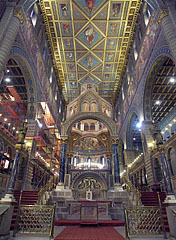
Sanctuary of Cathedral of Pécs, in artificial lighting
Kuvauspäivämäärän: 20092009
Luonut: Robert Németh
Kameran malli: Konica Minolta Dimage A200
Pécs, Unkari
-
The sanctuary of the Basilica and Cathedral of Pécs (sometimes called "Castle Church")
Kuvauspäivämäärän: 20092009
Luonut: Robert Németh
Kameran malli: Konica Minolta Dimage A200
Pécs, Unkari
The sanctuary of the Basilica and Cathedral of Pécs (sometimes called "Castle Church") - Pécs, Unkari -
The Angster brand church organ on the choir loft of the Cathedral of Pécs
The instrument was constructed in 1887, renovated and modernized in 2008.
Kuvauspäivämäärän: 20092009
Luonut: Robert Németh
Kameran malli: Konica Minolta Dimage A200
Pécs, Unkari
The Angster brand church organ on the choir loft of the Cathedral of Pécs - Pécs, Unkari -
The sanctuary with the main altar (the so-called "people's altar with a canopy or baldachin")
Kuvauspäivämäärän: 20092009
Luonut: Robert Németh
Kameran malli: Konica Minolta Dimage A200
Pécs, Unkari
The sanctuary with the main altar (the so-called "people's altar with a canopy or baldachin") - Pécs, Unkari -
Interior of the Cathedral and Basilica of Pécs, with the so-called "triumphal Arch"
This separates the sanctuary from the nave.
Kuvauspäivämäärän: 20092009
Luonut: Robert Németh
Kameran malli: Konica Minolta Dimage A200
Pécs, Unkari
Interior of the Cathedral and Basilica of Pécs, with the so-called "triumphal Arch" - Pécs, Unkari -
Pictures of apostles (bigger figures) and saints (smaller figures) on the oak wooden coffered ceiling
Kuvauspäivämäärän: 20092009
Luonut: Robert Németh
Kameran malli: Konica Minolta Dimage A200
Pécs, Unkari
Pictures of apostles (bigger figures) and saints (smaller figures) on the oak wooden coffered ceiling - Pécs, Unkari -
Pictures of apostles and saints on the coffered (or paneled) wooden ceiling
Kuvauspäivämäärän: 20092009
Luonut: Robert Németh
Kameran malli: Konica Minolta Dimage A200
Pécs, Unkari
Pictures of apostles and saints on the coffered (or paneled) wooden ceiling - Pécs, Unkari -
The nave and the side-aisles of the church, with great columns
Kuvauspäivämäärän: 20092009
Luonut: Robert Németh
Kameran malli: Konica Minolta Dimage A200
Pécs, Unkari
The nave and the side-aisles of the church, with great columns - Pécs, Unkari -
Reliefs under restauration at the northern stairs downto the crypt (in other words the lower church)
Kuvauspäivämäärän: 20092009
Luonut: Robert Németh
Kameran malli: Konica Minolta Dimage A200
Pécs, Unkari
Reliefs under restauration at the northern stairs downto the crypt (in other words the lower church) - Pécs, Unkari -
The walls of the church naves are covered with the paintings of Karl Andreä and Moritz von Beckerath Austrian painters
Kuvauspäivämäärän: 20092009
Luonut: Robert Németh
Kameran malli: Konica Minolta Dimage A200
Pécs, Unkari
The walls of the church naves are covered with the paintings of Karl Andreä and Moritz von Beckerath Austrian painters - Pécs, Unkari -
Mary's Chapel, one of the four side-chapels in the Cathedral of Pécs
Kuvauspäivämäärän: 20092009
Luonut: Robert Németh
Kameran malli: Konica Minolta Dimage A200
Pécs, Unkari
Mary's Chapel, one of the four side-chapels in the Cathedral of Pécs - Pécs, Unkari -
Painting of Bertalan Székely: "Stephen I King of Hungary offers the crown to Virgin Mary who sits on the throne", with the Mary's Altar is under it
Kuvauspäivämäärän: 20092009
Luonut: Robert Németh
Kameran malli: Konica Minolta Dimage A200
Pécs, Unkari
Painting of Bertalan Székely: "Stephen I King of Hungary offers the crown to Virgin Mary who sits on the throne", with the Mary's Altar is under it - Pécs, Unkari -
Church art exhibition in the Mary's Chapel
Kuvauspäivämäärän: 20092009
Luonut: Robert Németh
Kameran malli: Konica Minolta Dimage A200
Pécs, Unkari
Church art exhibition in the Mary's Chapel - Pécs, Unkari -
The alabaster epitaph altar from the 17th century Rome, and above it there's a picture from Bertalan Székely: "St. Maurus Bishop of Pécs presents a sacrifice"
Kuvauspäivämäärän: 20092009
Luonut: Robert Németh
Kameran malli: Konica Minolta Dimage A200
Pécs, Unkari
The alabaster epitaph altar from the 17th century Rome, and above it there's a picture from Bertalan Székely: "St. Maurus Bishop of Pécs presents a sacrifice" - Pécs, Unkari -
The apse of the crypt with the altar and paintings of Bertalan Székely famous Hungarian painter
Kuvauspäivämäärän: 20092009
Luonut: Robert Németh
Kameran malli: Konica Minolta Dimage A200
Pécs, Unkari
The apse of the crypt with the altar and paintings of Bertalan Székely famous Hungarian painter - Pécs, Unkari -
Bishop Nándor Dulánszky's tomb in the lower church (crypt)
Kuvauspäivämäärän: 20092009
Luonut: Robert Németh
Kameran malli: Konica Minolta Dimage A200
Pécs, Unkari
Bishop Nándor Dulánszky's tomb in the lower church (crypt) - Pécs, Unkari -
Stairs leading to the lower church (the crypt)
Kuvauspäivämäärän: 20092009
Luonut: Robert Németh
Kameran malli: Konica Minolta Dimage A200
Pécs, Unkari
Stairs leading to the lower church (the crypt) - Pécs, Unkari -
Replica of a romanesque relief at the crypt entrance, with scenes from the life of Samson
The replica was created by György Zala in 1889.
Kuvauspäivämäärän: 20092009
Luonut: Robert Németh
Kameran malli: Konica Minolta Dimage A200
Pécs, Unkari
Replica of a romanesque relief at the crypt entrance, with scenes from the life of Samson - Pécs, Unkari -
The Cathedral of Pécs, viewed from the Bishop's Palace
Kuvauspäivämäärän: 20092009
Luonut: Robert Németh
Kameran malli: Konica Minolta Dimage A200
Pécs, Unkari
The Cathedral of Pécs, viewed from the Bishop's Palace - Pécs, Unkari -
Statue of Ferenc Liszt Hungarian composer at the Bishop's Palace
It was made of chrome steel metal sheets, created by Imre Varga in 1983.
Kuvauspäivämäärän: 20092009
Luonut: Robert Németh
Kameran malli: Konica Minolta Dimage A200
Pécs, Unkari
Statue of Ferenc Liszt Hungarian composer at the Bishop's Palace - Pécs, Unkari -
The amazingly lifelike metal sculpture of Ferenc Liszt Hungarian composer at the Bishop's Palace
Created by Imre Varga in 1983
Kuvauspäivämäärän: 20092009
Luonut: Robert Németh
Kameran malli: Konica Minolta Dimage A200
Pécs, Unkari
The amazingly lifelike metal sculpture of Ferenc Liszt Hungarian composer at the Bishop's Palace - Pécs, Unkari -
Northern steeples of the cathedral, with the unique five-pointed crosses on the top
Kuvauspäivämäärän: 20092009
Luonut: Robert Németh
Kameran malli: Konica Minolta Dimage A200
Pécs, Unkari
Northern steeples of the cathedral, with the unique five-pointed crosses on the top - Pécs, Unkari -
One of the two obelisks, that stands here since 1890, and the Episcopal Archives building
The obelisks were brought here from the nearby Budafa stone pit.
Kuvauspäivämäärän: 20092009
Luonut: Robert Németh
Kameran malli: Konica Minolta Dimage A200
Pécs, Unkari
One of the two obelisks, that stands here since 1890, and the Episcopal Archives building - Pécs, Unkari -
The outer door of the cathedral is called the "Millenium Gate", it weights 2500 kilograms
It was made of bronze by Sándor Rétfalvi in 2000.
Kuvauspäivämäärän: 20092009
Luonut: Robert Németh
Kameran malli: Konica Minolta Dimage A200
Pécs, Unkari
The outer door of the cathedral is called the "Millenium Gate", it weights 2500 kilograms - Pécs, Unkari -
The southern main gate of the Cathedral of Pécs, with statues of the apostles on the top
Kuvauspäivämäärän: 20092009
Luonut: Robert Németh
Kameran malli: Konica Minolta Dimage A200
Pécs, Unkari
The southern main gate of the Cathedral of Pécs, with statues of the apostles on the top - Pécs, Unkari -
"Adoration Our Lady of Hungary by the Hungarian saints", relief sculpture of Virgin Mary over the main door
Sculpted by György Kiss in 1891
Kuvauspäivämäärän: 20092009
Luonut: Robert Németh
Kameran malli: Konica Minolta Dimage A200
Pécs, Unkari
"Adoration Our Lady of Hungary by the Hungarian saints", relief sculpture of Virgin Mary over the main door - Pécs, Unkari -
The southern side-sanctuary (or sub-sanctuary)
Kuvauspäivämäärän: 20092009
Luonut: Robert Németh
Kameran malli: Konica Minolta Dimage A200
Pécs, Unkari
The southern side-sanctuary (or sub-sanctuary) - Pécs, Unkari -
Holy mass in the Basilica of Pécs, viewed from the southern side-sanctuary
Kuvauspäivämäärän: 20092009
Luonut: Robert Németh
Kameran malli: Konica Minolta Dimage A200
Pécs, Unkari
Holy mass in the Basilica of Pécs, viewed from the southern side-sanctuary - Pécs, Unkari -
The southern side-sanctuary, including the Altar of St. Stephen of Hungary
Created by György Zala
Kuvauspäivämäärän: 20092009
Luonut: Robert Németh
Kameran malli: Konica Minolta Dimage A200
Pécs, Unkari
The southern side-sanctuary, including the Altar of St. Stephen of Hungary - Pécs, Unkari -
The sanctuary of the Cathedral Basilica of Pécs with the columned ciborium (large canopy over the altar), during the Holy Mass
Kuvauspäivämäärän: 20092009
Luonut: Robert Németh
Kameran malli: Konica Minolta Dimage A200
Pécs, Unkari
The sanctuary of the Cathedral Basilica of Pécs with the columned ciborium (large canopy over the altar), during the Holy Mass - Pécs, Unkari -
Way down to the lower church (or crypt), with the replicas of the "Biblia pauperum" reliefs from the late 12th century
These replicas were created by György Zala
Kuvauspäivämäärän: 20092009
Luonut: Robert Németh
Kameran malli: Konica Minolta Dimage A200
Pécs, Unkari
Way down to the lower church (or crypt), with the replicas of the "Biblia pauperum" reliefs from the late 12th century - Pécs, Unkari -
The bronze dove figure on the Millenium Gate symbolizes the "outpouring of the Holy Spirit"
Created by Sándor Rétfalvi in 2000
Kuvauspäivämäärän: 20092009
Luonut: Robert Németh
Kameran malli: Konica Minolta Dimage A200
Pécs, Unkari
The bronze dove figure on the Millenium Gate symbolizes the "outpouring of the Holy Spirit" - Pécs, Unkari -
The Millenium Gate with bronze motifs of grape vines and bunches
Created by Sándor Rétfalvi sculptor from Pécs in 2000.
Kuvauspäivämäärän: 20092009
Luonut: Robert Németh
Kameran malli: Konica Minolta Dimage A200
Pécs, Unkari
The Millenium Gate with bronze motifs of grape vines and bunches - Pécs, Unkari -
The southern gate of the Cathedral
Kuvauspäivämäärän: 20092009
Luonut: Robert Németh
Kameran malli: Konica Minolta Dimage A200
Pécs, Unkari
The southern gate of the Cathedral - Pécs, Unkari -
The building of the Episcopal Archives with the glass roof of the Cella Septichora
Kuvauspäivämäärän: 20092009
Luonut: Robert Németh
Kameran malli: Konica Minolta Dimage A200
Pécs, Unkari
The building of the Episcopal Archives with the glass roof of the Cella Septichora - Pécs, Unkari -
The contemorary entrance of the Early Christian (4th century) "Cella Septichora" archaeological site (and the towers of the cathedral in the distance)
Kuvauspäivämäärän: 20092009
Luonut: Robert Németh
Kameran malli: Konica Minolta Dimage A200
Pécs, Unkari
The contemorary entrance of the Early Christian (4th century) "Cella Septichora" archaeological site (and the towers of the cathedral in the distance) - Pécs, Unkari -
Usually the statue of bishop Ignác Szepesy stands in the square in front of the basilica, but it was just removed in 2009
The statue was removed from here due to restoration and one year later it was placed back to here.
Kuvauspäivämäärän: 20092009
Luonut: Robert Németh
Kameran malli: Konica Minolta Dimage A200
Pécs, Unkari
Usually the statue of bishop Ignác Szepesy stands in the square in front of the basilica, but it was just removed in 2009 - Pécs, Unkari -
The Cathedral Basilica of Pécs is the only one church in Hungary with four main towers (aka steeples)
Kuvauspäivämäärän: 20092009
Luonut: Robert Németh
Kameran malli: Konica Minolta Dimage A200
Pécs, Unkari
The Cathedral Basilica of Pécs is the only one church in Hungary with four main towers (aka steeples) - Pécs, Unkari -
The wall remains of the former chapel over the Peter and Paul burial chamber, in the square in front of the cathedral basilica
Kuvauspäivämäärän: 20092009
Luonut: Robert Németh
Kameran malli: Konica Minolta Dimage A200
Pécs, Unkari
The wall remains of the former chapel over the Peter and Paul burial chamber, in the square in front of the cathedral basilica - Pécs, Unkari
Klikkaa kuvia!
Ominaisuudet, piirteet
Sijainti:
GPS-koordinaatit: Leveysaste 46°4'42", Pituusaste 18°13'25" (N46 4.7 - E18 13.42)
Yhteystiedot, lyhyitä tarinoita, mielenkiintoiset
 Cathedral of Pécs, sanctuary with the columned ciborium altar, in natural light
Cathedral of Pécs, sanctuary with the columned ciborium altar, in natural light
The covered canopy structure which is standing on columns and appears in the sanctuary of some catholic churches is the so-called "ciborium" (from the Greek word "ciborion"). Its origin dates back to the ancient Romans, who wanted to highlight the important or privileged places with this solution. At that time a stone of wooden canopy was usually belonged to it.
Today the most beautiful ciborium is located in the St. Peter's Basilica in Rome, that one was created by Giovanni Lorenzo Bernini in 1633. There's another example in the San Pietro in Vincoli ("Saint Peter in Chains") minor basilica, also in Rome, Italy. In the modern times church architecture the ciborium is very rarely used, so the Cathedral of Pécs is very special in this regard, because there is one such structure within its sanctury. This is the so-called "Canopied People's Altar" or "Ciborium People's Altar", created by György Zala at the end of the 19th century, so it is relatively new (although there was a similar structure in the sanctuary of the original Romanesque church). The People's Altar was needed because the high altar (or main altar) cannot be seen from the nave (the floor of the sanctuary should be raised due to the crypt).
by the way, the ciborium word has another meaning as well, which is also related to the church: a drinking cup or chalice-like closable covered vessel, which is an accessory of the liturgy (religious ceremony) of the Catholic and the Anglican Church and used to store the communion wafer (in other words the "sacramental bread").
 Pictures of apostles and saints on the coffered (or paneled) wooden ceiling
Pictures of apostles and saints on the coffered (or paneled) wooden ceiling
The Cathedral of Pécs was the first church in Hungary that received air conditioning to prevent the restored works of art and the furnishings from the deterioration.
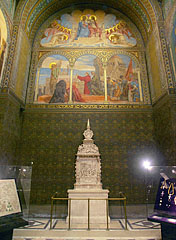 The alabaster epitaph altar from the 17th century Rome, and above it there's a picture from Bertalan Székely: "St. Maurus Bishop of Pécs presents a sacrifice"
The alabaster epitaph altar from the 17th century Rome, and above it there's a picture from Bertalan Székely: "St. Maurus Bishop of Pécs presents a sacrifice"
Europe's (and maybe the world's) biggest alabaster sculpture is kept within the St. Mary's side-chapel in the Cathedral of Pécs. The alabaster epitaph altar was created in the 16th or 17th century and initially intended to be a tombstone, probably a work of an unknown Dutch master (some sources suggest that it was created in the workshop of Cornelius Floris for a rich Medici). It was made during about 20 years, because the soft material couldn't be carved, just furbished and polished. However, using this method it was also possible to finish even more finer details, for example the facial expressions of the human figures, which is very unusual concerning the alabaster sculptures.
It was arrived to Hungary in courtesy of László Esterházy bishop of Pécs, who brought from Rome to Pécs in 1787 and paid a tremendous amount for it (it is another matter how could he have such a lot of money).
The alabaster is a fine-grained gypsum rock. The sculpture that is made of it became somewhat transparent when illuminated with bright light. It has more color variations, but the white is the most precious anyway. It is hard and time-consuming to work with it, to furbish and polish it.
The Ancient Greek and Latin-derived word "epitaph" means "funeral oration" or "grave inscription". Nowadays it is often used for a framed inscribed picture, plaque or relief in a church or chapel, with inscription in memory of the dead.
 The columns of the late-11th-centiry-built five-aisled lower church or crypt
The columns of the late-11th-centiry-built five-aisled lower church or crypt
The tomb of Janus Pannonius Hungarian poet and bishop can be found on the left edge of the picture.
In 1991 during the renovation of the Pécs Cathedral bones were found, and these already then seemed to be the mortal remains of the Hungarian humanist poet and bishop Janus Pannonius (1434-1472). The anthropological investigations of 2008 confirmed it. Finally the body of Janus Pannonius was buried in the lower church (crypt) of the basilica, his final resting place is now situated on the western wall near the grave of bishop Nándor Dulánszky.
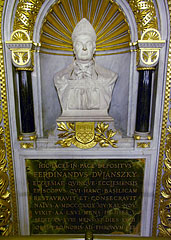 Bishop Nándor Dulánszky's tomb in the lower church (crypt)
Bishop Nándor Dulánszky's tomb in the lower church (crypt)
The Cathedral Basilica of St. Peter and St. Paul in Pécs reached its current form after the modifications between 1882-1891. The reconstruction was ordered in 1877 on behalf of the Church by bishop Nándor Dulánszky, whose tomb and bust is located in the crypt of the cathedral. The alteration works were led by the Austrian architect Friedrich von Schmidt, the primary objective was to restore the original Romanesque character of the church, as it was in the age of the Árpád dinasty in the 11th century. However, in the meantime unfortunately a lot of such values were dismantled or sold that were built in earlier but did not fit into the Romanesque style. These were mostly baroque fixtures and furnishings. Fortunately some of them were placed into the surrounding parish churches, these ones still can be seen today.
 The southern main gate of the Cathedral of Pécs, with statues of the apostles on the top
The southern main gate of the Cathedral of Pécs, with statues of the apostles on the top
There are statues of the Apostles over the southern facade of the Cathedral Basilica of Pécs. Although they may look old, but in reality they are not. The original statues were created in 1854, these ones still can be seen in the yard of the Episcopal Theological College of Pécs (in Hungarian "Pécsi Püspöki Hittudományi Főiskola") an 1 Papnövelde utca (street). Then in 1891 another apostle statue series was created, but due to the used poor quality sandstone (like initially in case of the Hungarian Parliament Building in Budapest) they became ruined soon. Only two of them survived, these are standing in the garden of the Bishop's Palace. The current relatively modern style apostle statues were created by Károly Antal in 1961.
Pécs - Lisää kuvagallerioita:
Saatat myös olla kiinnostunut (Liittyviä sivuja):
Kohteet matkaopas:
Pécs (225 valokuvaa + 3 panoraamakuvia)
Mecsek Mountains (304 valokuvaa + 3 panoraamakuvia)
Baranya megye (county) (857 valokuvaa + 4 panoraamakuvia)
Etelä Transdanubia (Dél-Dunántúl) (1 597 valokuvaa + 8 panoraamakuvia)
Unkari (27 287 valokuvaa + 163 panoraamakuvia)
ja lisäksi:
(sisällä tässä: Mecsek Mountains)
Abaliget (10 valokuvaa)
Magyaregregy (69 valokuvaa)
Orfű
Püspökszentlászló
Kaikki panoraamakuva tästä:
Pécs (3 valokuvaa)
Baranya megye (county) (4 valokuvaa)
Etelä Transdanubia (Dél-Dunántúl) (8 valokuvaa)
Unkari (163 valokuvaa)
Eurooppa (165 valokuvaa)
Jokainen normaali valokuva tästä:
Pécs (225 valokuvaa / 4 galleriat)
Mecsek Mountains (304 valokuvaa / 6 galleriat)
Baranya megye (county) (857 valokuvaa / 17 galleriat)
Etelä Transdanubia (Dél-Dunántúl) (1 597 valokuvaa / 32 galleriat)
Unkari (27 287 valokuvaa / 462 galleriat)
Eurooppa (30 494 valokuvaa / 523 galleriat)
https://www.panadea.com/fi/guidebook/pecs/photos/gal-003

Lisää Suosikkeihin Lisää Kirjanmerkkeihin
Jaa ystäviesi kanssa!
jne.
Tietoa meistä - Yleiset ehdot ja Tietosuoja -
Kaikki oikeudet pidätetään
- ©2010-2022
Neuronit Creative Studio - Mogyoród / Budapest / Unkari





